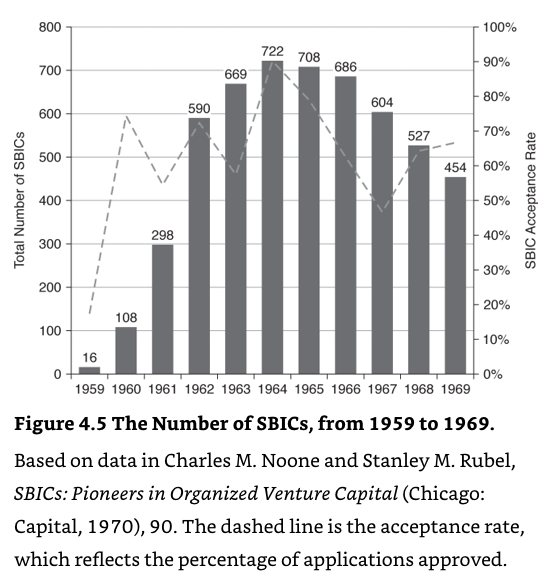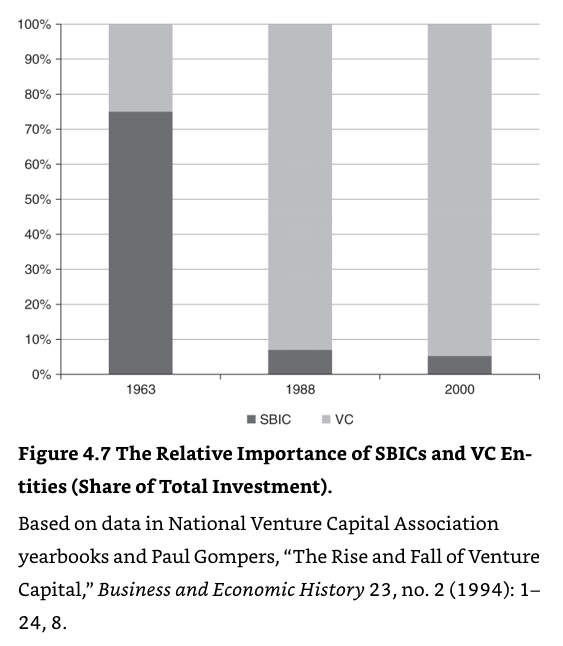The New Business Preservation Act and the Tradition of U.S. Federal Government Support for Entrepreneurship and Venture Capital
March 31, 2020
March 31, 2020

Earlier this month, a group of U.S. Senators led by Amy Klobuchar introduced the New Business Preservation Act to incentivize venture capital formation around the country. The Act, which allocates $2 billion to states under the “Innovation and Startups Equity Investment Program,” enables investors in undercapitalized regions to leverage federal dollars into startup investments. It avoids two well-known traps for government-sponsored venture programs by requiring that public funds are matched with private dollars and that capital is deployed by professional investors.
The Act also continues a long-standing tradition of U.S. federal government involvement in the formation and development of the venture capital industry.
Although many of its modern inhabitants don’t like to admit it, Silicon Valley owes much of its existence to the U.S. federal government. That is not to say that Silicon Valley isn’t the product of human ingenuity and agency. Clearly, it is. Some of the hardest working and most brilliant minds on the planet have been shaping the world’s leading innovation ecosystem for decades. But that doesn’t change the fact the U.S. government played a decisive role in getting the whole thing kickstarted, and for a period of time, sustained its development in the early stages.
The clearest mechanism for this support was wartime expenditures on research and development by the U.S. Department of Defense during World War II and the Cold War that followed. This “mission-driven state” generated enormous demand for computing and communications technologies, which shaped entire industries around Boston and Silicon Valley. As venture capitalist and economic historian Bill Janeway remarked: “… the federal government funded construction of a platform on which entrepreneurs and venture capitalists could dance.”
What may be less known is the federal government’s central role in the birth and early development of the venture capital industry specifically. No one tells this story better than Harvard Business School professor Tom Nicholas in his recent book VC: An American History. This post summarizes the parts of his book that deal with U.S. government policy. It shows that the New Business Preservation Act and the Innovation and Startups Equity Investment Program it establishes would not be a radical departure from precedent, but rather, an evolution on more than six decades of government support of venture capital in America.
The U.S. federal government played a major role in developing the venture capital industry early on, through key actions during the late-1950s through the mid-1970s. Three major policy interventions—one direct, two indirect—had the effect of increasing venture capital deployment through both the supply side (limited partners and venture capitalists) and the demand side (entrepreneurs).
The first of these interventions was the Small Business Act, passed in 1958, which funneled public funds to qualified small business investment companies (SBICs). SBICs acted as venture capitalists by leveraging private capital with public funds. Public funds were made available under preferential tax treatment and attractive borrowing terms—if successful, the federal government didn’t require a return on investment, just a return of the principal. In exchange for generous benefits, SBICs were forced to comply with strict regulatory oversight, which made them unattractive for some early investors. Nonetheless, SBIC was a key on-ramp for many new fund managers.
As the data show, the growth of SBICs was slow at first, but peaked quickly and then tapered off just as fast. SBIC returns were mostly poor and interest from new entrants eventually waned. Even many of the larger, better performing SBICs returned little more than the S&P Composite index (a common benchmark for investment performance).

Source: Nicholas (2019), VC: An American History.

Source: Nicholas (2019), VC: An American History.
The lack of early returns from SBICs highlighted three key challenges to venture investing generally, which are highlighted in various context throughout Nicholas’s book. Each of them is a lesson the new legislation should consider:
Those challenges aside, the SBIC program made five major contributions to the development of venture capital in America—the significance of which should not be understated, particularly as many other nations and the U.S. states continue to experiment with ways to spark entrepreneurial finance.
The SBIC program continues to this day, supporting more than 300 investment firms each year. Although the program’s goals have shifted to becoming more of a support mechanism for mezzanine finance (later stage), the program’s influential place in sparking a nascent venture capital industry during the 1950s and 1960s in the United States is unquestionable. It also provided the template from which governments around the world have drawn upon to spark venture capital formation in their country.
Two policy changes occurred in the 1970s that significantly improved the environment for entrepreneurship and venture capital to thrive—opening up both the supply and demand channels. Unlike with the SBICs, which were a form of direct government intervention in venture capital, these indirect “enabling” policies were meant to improve conditions for private actors to operate within.
By the mid-1970s, the venture capital industry was still fairly small, with no more than 30 firms of any real substance. But things changed dramatically after Congress amended the “prudent man” rule of the 1974 Employee Retirement Income Security Act (ERISA), which was implemented to protect individual pension and health plans. Under the Act, pension fund managers (as passive investors) could be held liable for breaching their fiduciary duty if the venture fund managers they invested in acted improperly. This had the impact of generally freezing out pension funds—an enormous source of institutional capital—from investing in the venture capital asset class.
In the year after ERISA was passed, pension fund investments into venture capital fell to zero, and was negligible over the next few years. But after Congress passed a 1979 amendment to relax the prudent man rule, pension fund commitments into venture funds skyrocketed. New pension fund commitments to venture funds doubled in the first year—making it the largest source of funding for venture capital funds. By the mid-1980s, net new commitments into venture capital funds increased by a factor of ten, and pension funds were the single largest source driving this change.
A second major policy change during the 1970s—the lowering of the federal capital gains tax rate—fueled the rapidly growing venture capital industry as well. In the late-1970s, the maximum marginal rate on capital gains was nearly 50 percent. Through the policy change, it was reduced dramatically to 20 percent throughout the first half of the 1980s. While many organized interests contributed to this change in policy, in the book, Nicholas documents the venture capital industry’s central role among them.
However, it’s important to note that a reduction in the capital gains tax rate was likely not a major contributor to the expansion of the supply of venture capital, but more so, it worked to increase the demand for venture capital. Why? For starters, many institutional investors are tax exempt. One influential academic study demonstrated that the growth in new venture capital commitments during the late-1970s to mid-1980s was driven the most by tax-exempt investors, while investors most sensitive to the tax change (high net worth individuals) actually saw their share of contributions to venture funds decline. The implication from this and other research indicates that reductions in capital gains taxes work to increase the demand for venture capital (the supply of entrepreneurs), because it increases the potential return to their investment (sweat equity and likely lower wages) over the opportunity cost (likely higher wages, benefits, and income stability via employment).
These two major regulatory and tax changes in the late-1970s and early-1980s enabled the venture capital industry and the startups it supports to accelerate into a rapid growth phase into the 1980s and throughout the 1990s.
Direct government action in venture capital returned in 1982 with the launch of the Small Business Innovation Research program. The program sought to fill the “funding gap” for early-stage, high-technology startups that were (a) reluctant to cede substantial portions of equity to investors, and (b) not being served by existing programs such as SBICs (which began funding later-stage companies).
The SBIR program, which deploys funds as grants or contracts to emerging small businesses through key federal government agencies, followed the staging structure of the venture capital model (Phase I proof of concept; followed by Phase II and III). The core objective of SBIR was to de-risk commercial opportunities in high-technology areas in an effort to attract more venture capital into the most promising ones. As Nicholas describes it in the book: “This was a government-funded platform designed to encourage creative technological development through the supply of seed money.” Later, Nicholas refers to SBIR as a program that encouraged “technology prototyping.”
The program remains highly active today, with $4 billion under authorization each year and $28 billion in assets under management. By most accounts, it is a success in spurring experimentation in high-risk areas that are less attractive to private investors. Innovation and entrepreneurship policy experts view the expansion of this program as a key lever for improving economic growth.
Though not a central focus of the book, the role of high-skilled immigration is present throughout it (and dominant in the modern history of entrepreneurship and venture capital in America). For Nicholas, this begins as early as the mid-1800s, when Samuel Slater, a British entrepreneur, was responsible for bringing the Industrial Revolution to the United States through a partnership with investor and industrialist Moses Brown. As detailed in the book, their partnership resembled a modern venture capital term sheet, and the industrial mill they developed was the “high-tech” industry of that time.
Nicholas discusses a number of other key immigrants throughout the book, including Eugene Kleiner (of the famed Silicon Valley venture firm Kleiner Perkins), Andy Grove (who was the founding CEO of Intel), entrepreneur and venture capitalist Vinod Khosla, and the father of modern venture capital, Arthur Rock (who was born an American but whose father immigrated from Russia), among others.
For a deeper examination of the role of immigration on high-technology innovation and entrepreneurship (and therefore, the demand for venture capital), see The Gift of Global Talent: How Migration Shapes Business, Economy & Society, an authoritative review of the evidence by Bill Kerr of Harvard Business School. His work shows that immigrants to the United States make outsized contributions to Nobel Prizes and patents, and to the founding of Silicon Valley high-tech companies, venture-backed startups, and to entrepreneurship overall.
Absent the unprecedented U.S. government appropriations on defense contacting and high-technology research and development, it’s hard to imagine that Silicon Valley would have become the envy of the world. U.S. government investments in science and innovation created many of the conditions that increased demand for venture capital (supply of technology and entrepreneurs), which wouldn’t have occurred otherwise.
In addition to “feeding the beast” of innovation via the mission-driven state, the U.S. government played a direct and decisive role in the development of venture capital.
Two manifestations of direct government interventions highlighted in the book—the SBIC program, which played an important role in catalyzing the nascent venture capital industry in the 1950s and 1960s, and the SBIR program, which stimulated early-stage company experimentation beginning in the early-1980s—continue today.
Two major policy changes in the 1970s—an amendment to the “prudent man” rule in the ERISA regulations that allowed pension funds to invest in venture capital, and the sharp reduction in the capital gains tax rate, which incentivized professionals to pursue startup opportunities by increasing the after-tax returns for doing so—were also critical.
Government investments in science and education—as illustrated in the book through the famous Genentech case, which was a partnership between government-funded research and private venture capital investors and entrepreneurs—produce the human and intellectual capital that underpins high-tech innovation and entrepreneurship today.
Finally, the U.S. government’s liberalized stance towards high-skill immigration throughout the 20th century created a major source of inbound talent for Silicon Valley and other innovative regions, and has been a key source of its continued success (though is in danger today).
The fingerprints of the U.S. federal government are all over the modern venture capital industry—providing key support at its nascency but also through the present day. Current support mechanisms include more permanent fixtures such as SBIR, and cyclical ones, such as the State Small Business Credit Initiative (SSBCI), which emerged out of the Obama Administration following the Great Recession. Indeed, Uncle Sam and venture capitalists have a deep relationship going back decades.
So, how well has the New Business Preservation Act absorbed the lessons of history? In my view, pretty well. By shifting fundraising (matching) and deployment to private actors (venture capitalists), the policy aims to divert the discomfort posed by long-tail venture returns and miscues around adverse selection (choosing unworthy investments) away from state policymakers. One potential pitfall is adverse selection of fund managers. To avoid this problem, policymakers should enlist experienced investment professionals to conduct rigorous screening upfront, and then relaxing requirements for qualifying funds (attracting the best fund managers by having few strings attached, but having the right people in place to identify who those fund managers are). These details can be ironed out once the bill passes. One potential criticism is size. I would like to see the program be much larger. However, the proposal is a completely reasonable size to start with given the novelty, competing public interests, and varying degrees of exposure to venture capital around the country.
Overall, the newly introduced New Business Preservation Act is a welcomed evolution and continuation of the U.S. government’s support of venture capital and entrepreneurship. Congress should adopt it immediately.